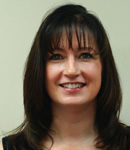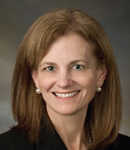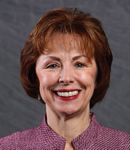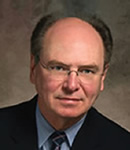Point & Counterpoint
Industry Experts Square Off on Sleep Topics
Respiratory Management asked experts in the sleep field to discuss their points of view on several controversial sleep topics impacting home respiratory providers and respiratory therapists. The idea was to gain insight by getting the perspective of the HME provider/RT and the sleep physician. Two experts in sleep education moderated the debate. Here’s what they had to say regarding the new compliance landscape; the role of auto PAP and titration; the new RT sleep specialty and bi-level therapy.
The Debaters

THE PROVIDER/RT
Rebecca Olson, RRT
Olson received a respiratory care practitioner’s degree from Western College in LaCrosse, Wis. In 2002, she left the hospital setting and joined Oxygen One, an HME respiratory provider in Waukesha, Wis., as a clinical specialist/sales rep. By 2004, Olson was performing sales full time, promoting and raising awareness of Oxygen One’s respiratory and sleep products and services to physicians, hospitals and clinics. In 2005, she became the manager of the respiratory care department and performed sales duties part time. Olson is currently the director of clinical and diagnostic services, overseeing patient services, patient care, the medical technicians and the warehouse.

THE SLEEP PHYSICIAN
Mary S. Esther, MD
Esther, the American Board of Sleep Medicine president, has been practicing Sleep Medicine for more than 20 years. She completed her residency in psychiatry and a fellowship in sleep medicine at the Mayo Clinic in Rochester, Minn., and was a faculty member at Mayo Clinic and later the University of Texas Health Sciences Center in San Antonio before moving to Charlotte, N.C. more than 12 years ago. She is specialty certified in Sleep Medicine through the American Board of Psychiatry and Neurology. She also is medical director of The Sleep Center at SouthPark, part of Charlotte Eye Ear Nose and Throat Associates, one of the largest multi-specialty ENT practices in the country. Dr. Esther was the Director of the National Sleep Medicine Course from 2000 to 2002 and is author of numerous articles on various sleep disorders and treatments. She has served since 2003 as a board member of the American Academy of Sleep Medicine. She received her undergraduate degree from the University of North Carolina at Chapel Hill North Carolina and her medical degree from the University of Missouri.
The Moderators

Kathryn Hansen
BS, REEGT, CPC
Hansen is the director of the Sleep Wellness Center for a large hospital in Kentucky. Known for her experience in sleep society leadership, accreditation and sleep grants/research, Hansen speaks extensively, providing more than 150 sleep-related presentations to business, industry and professional organizations annually. She serves on numerous multidisciplinary health care committees and assist sleep labs in preparation for Joint Commission surveys an accreditation site visits. Hansen is the executive director and past president of the Kentucky Sleep Society. She holds a degree in biological sciences form the University of Kentucky, and studied in the department of neurology at Mayo Clinic in Rochester, Minn. Hansen is also a registered electroneurodiagnostic technician and a certified professional coder. She is the senior Sleep Center Management Institute advisory team member with special focus and expertise in sleep lab accreditation and portable monitoring.

James C. O’Brien
MD, FCCP, Diplomate-ABSM
O’Brien is a medical physician who has been in private practice for 27 years. He became involved in sleep medicine more than 20 years ago when he began noticing that many of his patients harbored undiagnosed sleep disorders. During his medical career, O’Brien has worked as a primary care physician, pulmonologist and sleep physician, and has lectured numerous times to health care professionals in the United States and abroad about sleep disorders. Additionally, he has appeared on television and radio programs addressing the need for healthy sleep and early detection and treatment of sleep disorders. O’Brien received his medical degree from New York Medical College in 1975. He completed internal medicine, pulmonology and sleep medicine training in the Boston area where he resides. O’Brien is currently board certified in internal medicine, pulmonology and sleep medicine. He is a member of the SCMI Advisory team and also co-founder and president of TalkAboutSleep.com, a patient education Web site designed for sleep patients and professionals.
Topic 1: The New Compliance Landscape
Discuss the importance of compliance in terms of the new PAP LCD. What role will home care providers play in the future? Is it a good idea that the burden of compliance has shifted to home care providers?
The Debaters
Olson: I don’t think the burden of compliance shifted to home care providers; it’s always been on us. The difference is Medicare has given specific guidelines of what it wants as proof. These parameters make our job easier. Whether or not we agree with them, we know what Medicare expects — and so does the patient. That’s where I’ve seen the biggest change. Even though we’re responsible to prove compliance, the burden has shifted to the patient to be compliant. The mindset of “it’s covered by Medicare” is gone. Patients are aware of their responsibilities if they want long-term reimbursement of PAP equipment.
Esther: Taking care of patients with sleep-disordered breathing necessitates a comprehensive approach. Recognizing this, there is a growing body of evidence that compliance issues are critical in preventing the complications of untreated or poorly treated sleep apnea. There is evidence that patients with sleep-disordered breathing have improved compliance when followed by sleep-medicine physicians, when follow-up care is emphasized. It is the sleep-medicine physician who should synthesize the information and coordinate optimal care of the patient.
The Moderators
Hansen: Compliance is derived from evaluating evidence, which then is used to drive practice parameters. When we debate compliance, we have to look back at a collage of experiences to measure and define consistent outcomes that are used to define the compliance standards. Fortunately, this type of evidence requires a multicenter aggregate of data to help all of us in a clinical specialty to measure the effectiveness of our care plans. Being a clinical specialist in sleep medicine requires one to effectively integrate a consistent measure of the patient’s response to a care plan. CMS has provided us with a baseline for compliance. As we become more adept at measuring and reporting our outcomes, our compliance standards will augment our clinical care. Sleep medicine will improve with compliance standards, and we have the option to responsibly contribute to an appropriate use of healthcare resources.
O’Brien: Regarding the new CMS compliance requirements mandating a 70 percent compliance rate demonstrated over a 30-day period, within a 90-day window and requiring more than four hours of nightly use; such new requirements are intended to improve the less-than-ideal compliance levels currently associated with CPAP therapy. Poor CPAP compliance burdens the healthcare system and increases resource consumption. Such a compliance requirement is a step in the right direction regarding the setting of achievable standards in CPAP therapy. However, within this scenario, CMS will economically punish the homecare provider for failing to achieve this benchmark. Just imagine, if the sleep physician wouldn’t be paid, or if their patient wasn’t compliant to their CPAP therapy! In fact, another PSG, or use of BiPAP therapy would cost the system more, and there’s no data that it would change or improve future compliance.
Topic 2: Auto PAP and Titration
As home sleep testing to diagnose patients with OSA makes its way into the mainstream, the question of how a patient will be titrated will become an issue. Some believe that auto PAP devices are a good way to titrate those using HST for diagnosis. Currently, CMS does not reimburse more for auto PAP. Do you think that auto PAP should have higher reimbursement? What role do you think auto PAP should play in sleep therapy now and in the future?
The Debaters
Olson: I’m a big proponent of putting all patients on auto PAP for the first 30 days. Doing so allows acclimation to the pressure, reduction of airway inflammation, recovery of REM rebound and tracking of TRUE sleep habits over a period of time. It’s less expensive than lab titration and provides an album rather than a snapshot of the patient’s sleep. For predominate supine OSA patients, it’s the best to accommodate all positions. Even though Medicare doesn’t reimburse more for auto PAP, the difference in unit cost to the provider is minimal compared to the cost associated with noncompliance issues. If used strictly for titration, the device is cycled from one patient to the next — with only patients wanting to purchase the unit receiving new equipment. Done correctly, expenses decrease through inventory control, and revenue (profit margins) increases because of increased patient satisfaction and attrition.
Esther: The use of AutoPAP is outlined in the paper entitled “Practice parameters for the Use of Autotitrating Continuous Positive Airway Pressure Devices for Titrating pressures and Treating Adult Patients with Obstructive Sleep Apnea Syndrome: An Update for 2007.” This was published in a January 2008 issue of Sleep. The paper clearly outlines the times when AutoPAP may be used in the self-adjusting mode for treating OSA patients. It is clear from this paper that AutoPAP should be considered only in certain specific situations. Close clinical follow-up, when used, is essential to good patient care. More research is needed to outline which patients can be treated with AutoPAP. Study is also needed to validate the accuracy of those parameters that are downloaded by software that varies among devices.
The Moderators
Hansen: Clinical expertise is vital to determine which treatment modality is required to adequately and effectively treat a patient. One device is not applicable to all patients. Clinical experts trained in sleep medicine take the time to review data and the patient’s response in the titration study to define the efficacy of autopap therapy verses other technology. As well, it depends on which clinical setting one is practicing: post-operative, mild OSA, central hypoventilation syndrome or neuromuscular dysfunction. Clinical follow-up is required to determine how the specialist integrates the various devices for maximizing the desired treatment outcome.
O’Brien: The “optimal” CPAP pressure is the necessary pressure to alleviate any significant sleep-related breathing disturbances (SRBD) during REM sleep and while in the supine position. An optimal pressure may be a more dynamic pressure range in certain individuals. There’s probably an “optimal” pressure for NREM sleep and an “optimal” pressure when in the lateral or supine positions too. Some of the pressure-reduction technologies (Flex/EPR) may permit less than ideal or “optimal” CPAP pressures to be adequate for sleep initiation or maintenance. Research is needed to demonstrate what common sense dictates in the optimal management of our OSA patients.
Topic 3: RT Sleep Specialty
The American Association for Respiratory Care and the National Board for Respiratory Care has created a sleep specialty exam for respiratory therapists.Would this be a benefit for home respiratory therapists?
The Debaters
Olson: Any time respiratory care professionals have an opportunity to elevate ourselves we should take advantage of it. Whether or not this exam would benefit home care RTs specifically is questionable. Home care therapists typically focus on the treatment of OSA, and some may have never seen a raw data sleep study. Home care RTs that do not plan to work in a lab or with home sleep testing may decide that the time and expense of the credential are not worth it. In addition, depending on the requirements, many might not be eligible to take the exam. (Current rules require an RRT to work in a lab for three months prior to exam.) The credential may be a nice addition for new grads or for those looking to improve their current skill and professional level.
Esther: I have not seen the new specialty examination that is offered. I believe that all sleep technologists, no matter what their background, need to be appropriately educated to become sleep technologists. This training can be accomplished through a variety of pathways. I would refer those interested to the American Academy of Sleep Technologists Web site.
The Moderators
Hansen: I feel that clinical specialty is less of a debate than clinical competence. A clinical specialist with expertise achieves effective treatment outcomes regardless of his or her clinical specialty. This may be learned in any clinical domain. As with clinical compliance, we implement clinical standards to measure competence, and one measure of this is a specialty exam. The more important measure of this is the evidence that patients are satisfied with their treatment and the demonstration of clinical improvement.
O’Brien: I believe that sleep is a unique area in healthcare that can be accessed from more than one clinical orientation for the betterment of the field of sleep medicine, by increasing sleep awareness and in achieving the best care for our patients.
Topic 4: Bi-level Debate
Does bi-level therapy enhance compliance for CPAP patients? As providers try to meet compliance regulations, how do you think the role of bi-level therapy will change?
The Debaters
Olson: With Medicare’s PAP LCD, I’m sure more patients will be switched from CPAP to bi-level because of noncompliance. Doing so may be more beneficial to the HME than to the patient. The response I’ve received from physicians regarding the use of bi-level for compliance is that there isn’t enough data to support it. I think many still view bi-level as a treatment for ventilation issues, and physicians aren’t quick to provide an order because they don’t believe it will make a difference. Physicians also want to make sure the EPAP and IPAP pressures are appropriate and don’t want to put the patient through the added expense or trouble of a bi-level titration in the lab.
Esther: Again, the use of bi-level therapy is outlined in the practice parameters. See “Practice Parameters for the Use of Continuous and Bilevel Positive Airway Pressure Devices to Treat Adult Patients with Sleep-Related Breathing Disorders” (Sleep, Volume 29, No. 3, 2006). There is a need for more evidence regarding the benefit of the new flex capability on CPAP that has improved some patients’ abilities to tolerate CPAP. The involvement of sleep specialists in the long-term care of patients to improve compliance with treatment is critical. Under the practice parameters paper referenced above, bi-level may be useful in treating some forms of restrictive lung disease or hypoventilation syndromes.
The Moderators
Hansen: Competent sleep specialists are adept at defining the clinical indices and clinical responses necessary to use bi-level verses other technology. As well, the use of bi-level is dependent on the clinical setting in which the patient is being treated: recovery room versus home verses pulmonary rehabilitation services. We rely on our clinical practice parameters to aid in implementing the appropriate technology based on the diagnostic testing and history and physical exam. The more education we receive as sleep specialists about clinical outcomes related to the respective technology augments clinical competence to treat our patients. It is imperative that we continue to use good clinical research to promote integrating technology to effectively treat our patients.
O’Brien: Practice parameters support the use of BiPAP therapy in CPAP failures, as well as in patients with restrictive lung disease and in hypoventilation syndromes. Given the paucity of research in patients without restrictive lung disease or hypoventilation syndromes, who fail CPAP therapy, additional research, including the use of AutoPAP devices should enter the debate when it pertains to alternative treatment options with CPAP failures. The current PAP LCD, regarding options when threshold CPAP compliance rates are not achieved, will likely be more costly than it needs to be, given the current mandated clinical options (repeat PSG, BiPAP therapy).
This article originally appeared in the Respiratory Management July/August 2009 issue of HME Business.